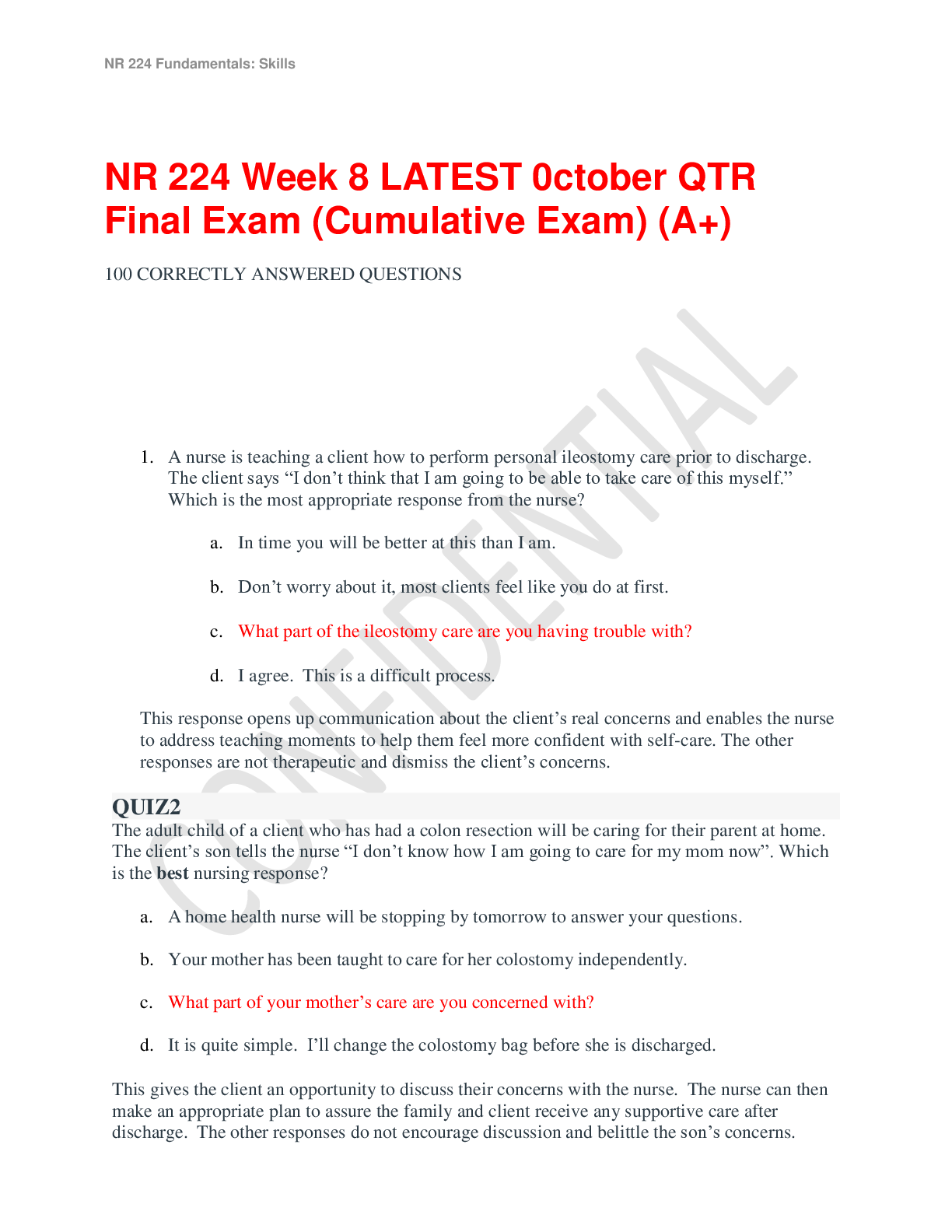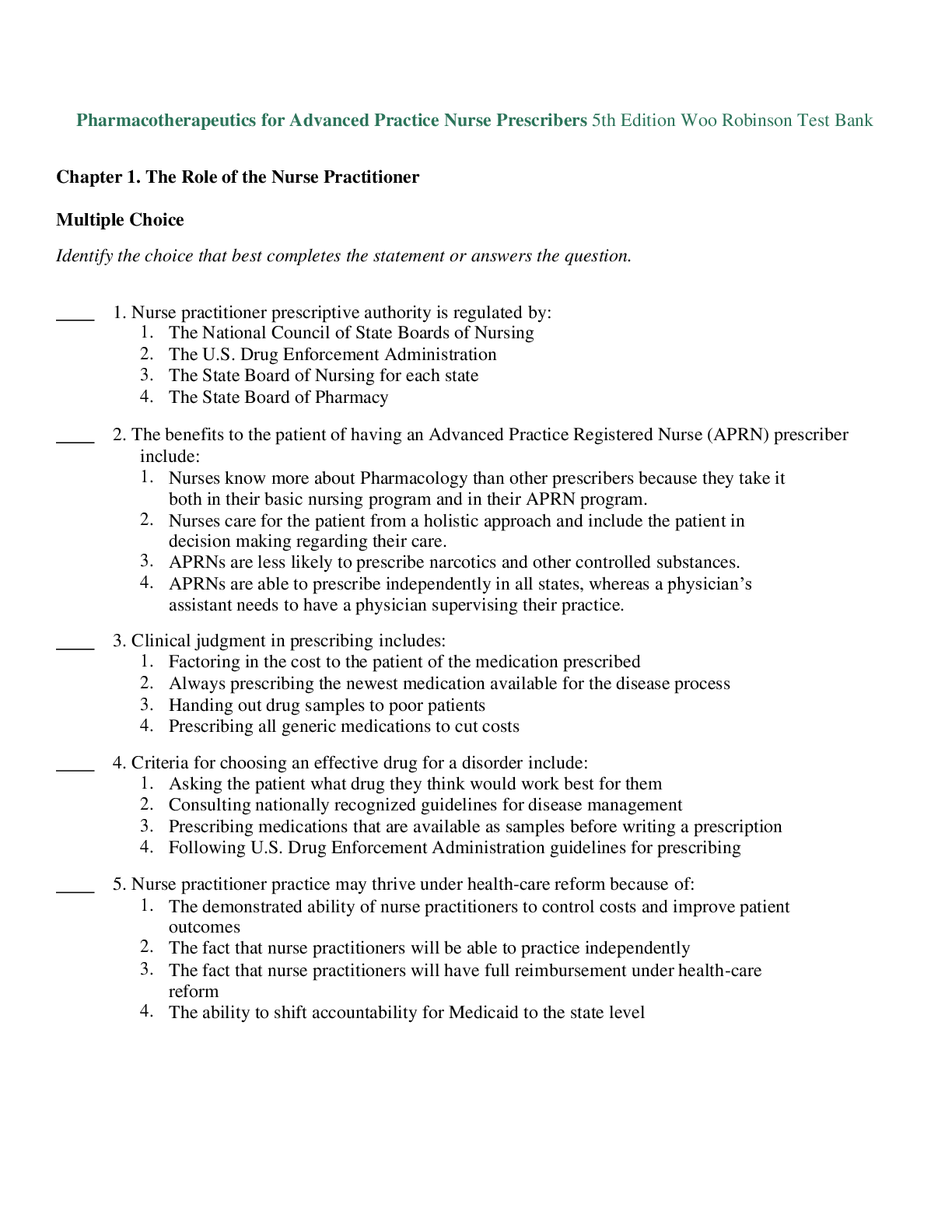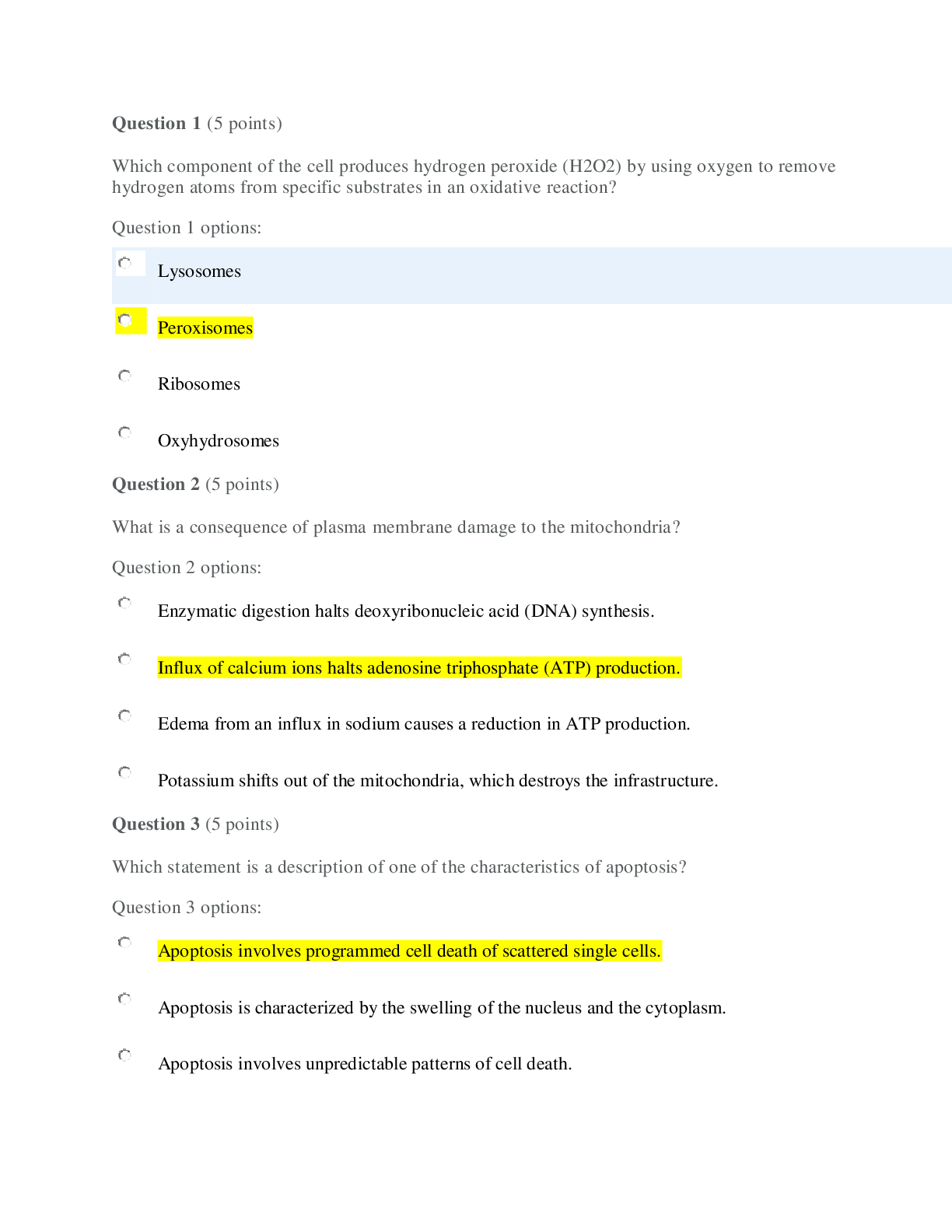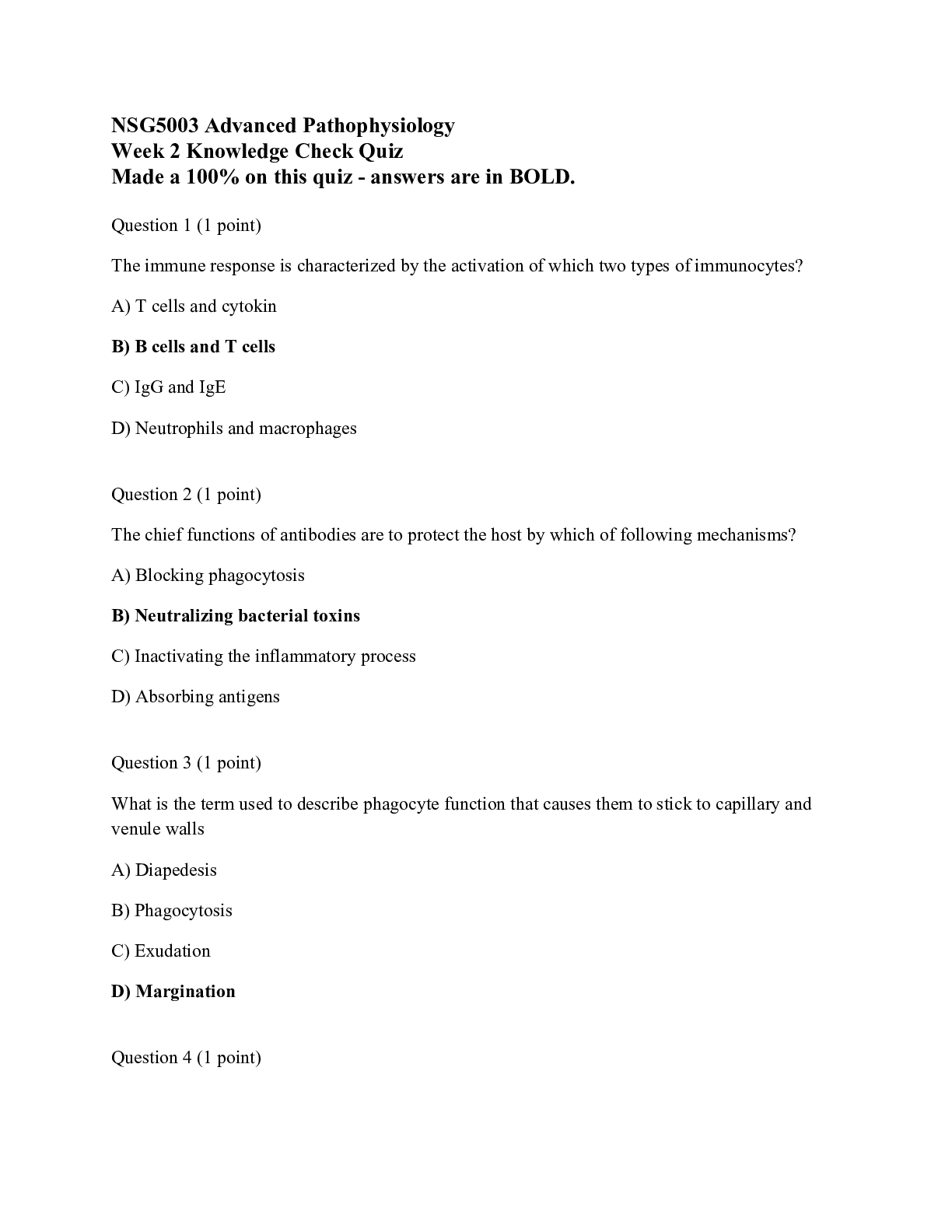*NURSING > QUESTIONS & ANSWERS > NSG 5003 Week 4 Knowledge Check Quiz (Latest): Advanced Pathophysiology: South University (Already g (All)
NSG 5003 Week 4 Knowledge Check Quiz (Latest): Advanced Pathophysiology: South University (Already graded A)
Document Content and Description Below
Question 1 (0.5 points) What is the effect of oxidized low-density lipoproteins (LDLs) in atherosclerosis? Question 1 options: a) LDLs cause smooth muscle proliferation. b) LDLs cause re... gression of atherosclerotic plaques. c) LDLs increase levels of inflammatory cytokines. d) LDLs direct macrophages to the site in the endothelium. Save Question 2 (0.5 points) Which inflammatory cytokines are released when endothelial cells are injured? Question 2 options: a) Granulocyte-macrophage colony-stimulating factor (GM-CSF) b) Interferon-beta (IFN-β), interleukin 6 (IL-6), and granulocyte colony-stimulating factor (G-CSF) c) Tumor necrosis factor–alpha (TNF-α), interferon-gamma (IFN-γ), and interleukin 1 (IL-1) d) Interferon-alpha (IFN-α), interleukin 12 (IL-12), and macrophage colony-stimulating factor (M-CSF) Save Question 3 (0.5 points) When endothelia cells are injured, which alteration contributes to atherosclerosis? Question 3 options: a) Toxic oxygen radicals that oxidize low-density lipoproteins (LDLs) are released. b) Cells are unable to make the normal amount of vasodilating cytokines. c) Cells produce an increased amount of antithrombotic cytokines. d) Cells develop hypersensitivity to homocysteine and lipids. Save Question 4 (0.5 points) Which factor is responsible for hypertrophy of the myocardium associated with hypertension? Question 4 options: a) Increased norepinephrine b) Adducin c) Angiotensin II d) Insulin resistance Save Question 5 (0.5 points) What effect does atherosclerosis have on the development of an aneurysm? Question 5 options: a) Atherosclerosis causes ischemia of the intima. b) Atherosclerosis increases nitric oxide. c) Atherosclerosis erodes the vessel wall. d) Atherosclerosis obstructs the vessel. Save Question 6 (0.5 points) Regarding the endothelium, what is the difference between healthy vessel walls and those that promote clot formation? Question 6 options: a) Inflammation and roughening of the endothelium of the artery are present. b) Hypertrophy and vasoconstriction of the endothelium of the artery are present. c) Excessive clot formation and lipid accumulation in the endothelium of the artery are present. d) Evidence of age-related changes that weaken the endothelium of the artery is present. Save Question 7 (0.5 points) Which form of angina occurs most often during sleep as a result of vasospasms of one or more coronary arteries? Question 7 options: a) Unstable b) Stable c) Silent d) Prinzmetal Save Question 8 (0.5 points) The pulsus paradoxus that occurs as a result of pericardial effusion is caused by a dysfunction in which mechanism? Question 8 options: a) Diastolic filling pressure of the right ventricle and reduction of blood volume in both ventricles b) Blood ejected from the right atrium and reduction of blood volume in the right ventricle c) Blood ejected from the left atrium and reduction of blood volume in the left ventricle d) Diastolic filling pressure of the left ventricle and reduction of blood volume in all four heart chambers Save Question 9 (0.5 points) Ventricular dilation and grossly impaired systolic function, leading to dilated heart failure, characterize which form of cardiomyopathy? Question 9 options: a) Congestive b) Hypertrophic c) Septal d) Dystrophic Save Question 10 (0.5 points) Amyloidosis, hemochromatosis, or glycogen storage disease usually causes which form of cardiomyopathy? Question 10 options: a) Infiltrative b) Restrictive c) Septal d) Hypertrophic Save Question 11 (0.5 points) In systolic heart failure, what effect does the renin-angiotensin-aldosterone system (RAAS) have on stroke volume? Question 11 options: a) Increases preload and decreases afterload b) Increases preload and increases afterload c) Decreases preload and increases afterload d) Decreases preload and decreases afterload Save Question 12 (0.5 points) What is the cause of the dyspnea resulting from a thoracic aneurysm? Question 12 options: a) Pressure on surrounding organs b) Poor oxygenation c) Formation of atherosclerotic lesions d) Impaired blood flow Save Question 13 (0.5 points) Which statement is true concerning the cells’ ability to synthesize cholesterol? Question 13 options: a) Cell production of cholesterol is affected by the aging process. b) Cells produce cholesterol only when dietary fat intake is low. c) Most body cells are capable of producing cholesterol. d) Most cholesterol produced by cells is converted to the low-density form. Save Question 14 (0.5 points) What is the trigger for angina pectoris? Question 14 options: a) Atherosclerotic lesions b) Hyperlipidemia c) Myocardial necrosis d) Myocardial ischemia Save Question 15 (0.5 points) Individuals being effectively managed for type 2 diabetes mellitus often experience a healthy decline in blood pressure as a result of which intervention? Question 15 options: a) Managed carbohydrate intake b) Appropriate exercise c) Insulin-sensitivity medication therapy d) Introduction of minimal doses of insulin Save Question 16 (0.5 points) Most cardiovascular developments occur between which weeks of gestation? Question 16 options: a) Fourth and seventh weeks b) Eighth and tenth weeks c) Twelfth and fourteenth weeks d) Fifteenth and seventeenth weeks Save Question 17 (0.5 points) The function of the foramen ovale in a fetus allows what to occur? Question 17 options: a) Right-to-left blood shunting b) Left-to-right blood shunting c) Blood flow from the umbilical cord d) Blood flow to the lungs Save Question 18 (0.5 points) An infant has a continuous machine-type murmur best heard at the left upper sternal border throughout systole and diastole, as well as a bounding pulse and a thrill on palpation. These clinical findings are consistent with which congenital heart defect? Question 18 options: a) Atrial septal defect (ASD) b) Ventricular septal defect (VSD) c) Patent ductus arteriosus (PDA) d) Atrioventricular canal (AVC) defect Save Question 19 (0.5 points) An infant has a crescendo-decrescendo systolic ejection murmur located between the second and third intercostal spaces along the left sternal border. A wide fixed splitting of the second heart sound is also found. These clinical findings are consistent with which congenital heart defect? Question 19 options: a) Atrial septal defect (ASD) b) Ventricular septal defect (VSD) c) Patent ductus arteriosus (PDA) d) Atrioventricular canal (AVC) defect Save Question 20 (0.5 points) An infant has a loud, harsh, holosystolic murmur and a systolic thrill that can be detected at the left lower sternal border that radiates to the neck. These clinical findings are consistent with which congenital heart defect? Question 20 options: a) Atrial septal defect (ASD) b) Ventricular septal defect (VSD) c) Patent ductus arteriosus (PDA) d) Atrioventricular canal (AVC) defect Save ________________________________________ [Show More]
Last updated: 2 years ago
Preview 1 out of 10 pages

Buy this document to get the full access instantly
Instant Download Access after purchase
Buy NowInstant download
We Accept:

Reviews( 0 )
$7.00
Can't find what you want? Try our AI powered Search
Document information
Connected school, study & course
About the document
Uploaded On
Apr 07, 2020
Number of pages
10
Written in
Additional information
This document has been written for:
Uploaded
Apr 07, 2020
Downloads
0
Views
121







.png)

















